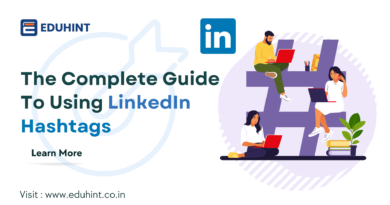5 min read10 Crucial Digital Marketing Strategies for Educational Institutions
To stay ahead of the competition and attract prospective students in today’s digital age. Educational institutions are increasingly recognizing the need of establishing effective digital marketing tactics. With the growing popularity of online learning and the more significant usage of digital platforms, educational institutions must harness the power of digital marketing to reach their target audience.
In this post, we will look at ten crucial digital marketing tactics for educational institutions. Institutions can improve their online presence, engage students, and increase enrollment numbers by implementing these tactics. Let’s dive into these.
Develop a Comprehensive Content Marketing Strategy:

A robust content marketing strategy forms the foundation of successful digital marketing for educational institutes. By creating high-quality, informative, and engaging content, institutes can establish themselves as industry thought leaders. Educational institutes should focus on developing content that addresses the pain points and challenges faced by students, such as college selection, career guidance, and exam preparation.
This can be achieved through blog posts, videos, infographics, and downloadable resources, thereby attracting and retaining their target audience.
Optimize Websites for Search Engines:

Search engine optimization (SEO) plays a crucial role in increasing online visibility and driving organic traffic website. Institutes should conduct keyword research to identify relevant search terms related to their programs and courses. Incorporating these keywords strategically throughout the website’s content, meta tags, and headings can significantly improve search engine rankings.
Additionally, optimizing page load speed, improving mobile responsiveness, and enhancing user experience contribute to higher search engine rankings.
Leverage Social Media Platforms:
Social media platforms provide an excellent opportunity for educational institutes to connect with their target audience on a personal level. Establishing a strong presence on platforms such as Facebook, Instagram, Twitter, and LinkedIn allows institutes to share updates, promote events, showcase student achievements, and engage in conversations.
Creating shareable content, running targeted ad campaigns, and leveraging user-generated content can effectively increase brand awareness and reach a wider audience.
Implement Pay-Per-Click (PPC) Advertising:
Pay-per-click advertising offers a highly targeted and measurable way to reach potential students. Institutes can create compelling ads using platforms like Google Ads or social media advertising tools, targeting specific geographic locations, demographics, and interests.
By carefully selecting relevant keywords and optimizing landing pages, educational institutes can drive qualified traffic to their website and increase conversions.
Harness the Power of Email Marketing:
Email marketing remains a powerful tool for nurturing leads and maintaining communication with prospective students. Institutes should build an email list by offering valuable resources, such as ebooks, newsletters, or exclusive event invitations, in exchange for email subscriptions.
Personalized and segmented email campaigns can then be used to deliver relevant information about courses, admissions, scholarships, and campus updates.
Building long-term relationships through regular and engaging email communication can positively impact student enrollment and retention rates.
Embrace Video Marketing:
Video content has become increasingly popular in the digital landscape, and educational institutes should capitalize on this trend. Creating engaging and informative videos about courses, campus life, testimonials from students, and faculty interviews can capture the attention of prospective students.
These videos can be shared on the institute’s website, social media platforms, and video-sharing platforms like YouTube. Incorporating video content in digital marketing efforts enhances storytelling, increases engagement, and boosts brand credibility.
Utilize Influencer Marketing:1
Collaborating with influential individuals in the education sector, such as industry experts, alumni, or well-known educators, can amplify the reach of an educational institute’s digital marketing campaigns. These influencers can share their experiences, endorse the institute’s programs, and provide valuable insights to prospective students.
By leveraging their credibility and social following, educational institutes can tap into new networks and gain trust and credibility among their target audience.
Implement Conversion Rate Optimization (CRO):
Conversion rate optimization focuses on improving the website’s performance to maximize the number of visitors who take desired actions, such as filling out inquiry forms, downloading brochures, or applying for admissions.
Educational institutes should analyze user behavior, conduct A/B testing, and optimize landing pages to enhance the conversion rate. By making data-driven decisions and continuously refining the user experience, institutes can increase their chances of converting website visitors into enrolled students.
Utilize Remarketing Techniques:
Remarketing allows educational institutes to stay top of mind with potential students who have previously shown interest in their programs or visited their website.
By placing a tracking pixel on their website, institutes can retarget these users with personalized ads as they browse other websites or social media platforms.
This technique reinforces brand awareness, reminds users of the institute’s offerings, and increases the likelihood of conversions.
Implement Analytics and Performance Tracking:
To ensure the success of digital marketing strategies, educational institutes should leverage web analytics tools. Such as Google Analytics, to track and measure key performance indicators (KPIs).
By monitoring website traffic, user engagement, conversion rates, and other relevant metrics, institutes can gain valuable insights into the effectiveness of their digital marketing efforts.
This data-driven approach enables institutes to identify areas for improvement, refine their strategies, and make informed decisions to optimize their online marketing campaigns continually.
Conclusion:
Digital marketing has become indispensable for educational institutes seeking to attract and engage with prospective students in the digital landscape. By implementing the ten essential strategies mentioned above. In this way institutes can enhance their online presence, increase brand visibility, and drive student enrollment.
Remember that digital marketing is an ongoing process, and institutes should continuously analyze and adapt their strategies based on changing trends and user behavior.
With a comprehensive digital marketing approach, educational institutes can stay ahead of the competition and achieve their enrollment goals in this digital era.





Pingback: How Budget Help You Avoid The Digital Marketing Traps? - EduHint